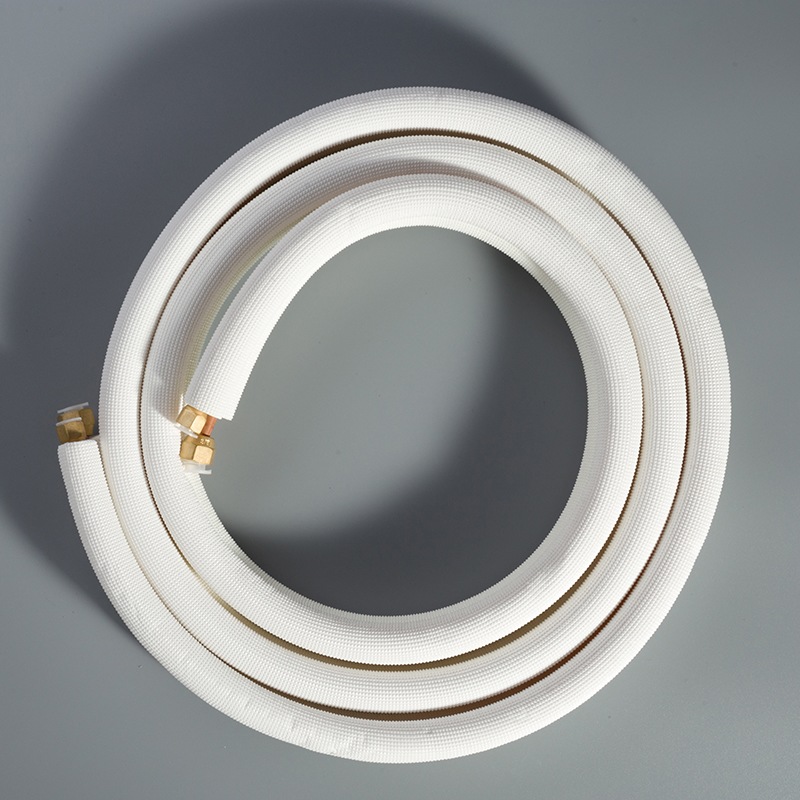What Are the Top Materials for Copper Pipe Insulation?

What materials are best for copper pipe insulation?
Insulating copper pipes is crucial for enhancing energy efficiency and preventing heat loss. By insulating these pipes, homeowners can significantly reduce their energy bills and minimize reheating demands. Additionally, proper insulation helps in preventing condensation build-up and protects the pipes from freezing during cold weather. Understanding the various materials available for insulation is essential to make an informed decision based on specific needs and conditions. Fiberglass pipe insulation materials work well with both cold and hot water pipes. It's best to use fiberglass insulation on copper pipes that transport hot water as they preserve the temperature better than other materials. Rubber pipe insulation and Armaflex pipe insulation are common and reliable options for insulating copper pipes. Polyethylene foam is considered to be the most efficient form of pipe insulation. Polyurethane foam insulation is a top choice for insulating copper pipes in HVAC systems due to its exceptional thermal insulation properties.
Common Materials for Copper Pipe Insulation
Foam Insulation
Foam insulation is a popular choice for insulating copper pipes due to its versatility and effectiveness in maintaining temperature levels. When considering foam insulation, it's essential to understand the different types available and their specific benefits.
Types of Foam Insulation
Polyurethane Foam: Known for its exceptional thermal resistance, polyurethane foam is a favorite among homeowners. It is created by that react and expand to form foam, which can be applied through spraying or injection into cavities, cracks, and other spaces requiring insulation.
EPS (Expanded Polystyrene): Composed of expanded and fused polystyrene beads, EPS forms a cellular structure that traps air, providing efficient insulation. This affordable option is easy to install and commonly used for insulating walls, floors, and roofs.
XPS (Extruded Polystyrene): With a denser composition and higher R-value, XPS is ideal for insulating foundations and roofs effectively.
Benefits of Foam Insulation
Thermal Resistance: Foam insulation materials like polyurethane foam offer excellent thermal resistance properties, helping to prevent heat loss and maintain energy efficiency.
Air Infiltration Prevention: By filling gaps and sealing spaces effectively, foam insulation reduces air infiltration, enhancing the overall insulation performance.
Ease of Installation: Many foam insulation options are easy to apply, whether through spraying or fitting into place. This simplifies the installation process for homeowners looking to insulate their copper pipes efficiently.
Fiberglass Insulation
When exploring options for copper pipe insulation, fiberglass insulation stands out as a reliable choice known for its versatility in both hot and cold water pipe applications. Understanding the characteristics and advantages of fiberglass insulation is crucial in making an informed decision.
Characteristics of Fiberglass Insulation
Fiberglass consists of fine glass fibers woven together to create a flexible yet sturdy material suitable for various pipe sizes.
The material's composition allows it to withstand high temperatures without compromising its insulating properties.
Benefits of Fiberglass Insulation
Temperature Preservation: Fiberglass insulation excels at preserving temperatures within pipes, making it an ideal choice for copper pipes carrying hot water.
Durability: The robust nature of fiberglass ensures long-lasting performance even in demanding conditions.
Versatility: Whether used in residential or commercial settings, fiberglass insulation adapts well to different environments while maintaining its effectiveness.
Rubber Insulation
For those seeking a durable and effective solution for copper pipe insulation, rubber insulation offers notable benefits that cater to various needs. Exploring the types available along with their advantages can help homeowners make informed choices when insulating their pipes.
Types of Rubber Insulation
Closed-cell Polyethylene Hot Water Pipe Insulation: This type provides improved thermal efficiency by reducing heat loss in residential and commercial hot water pipes. It also prevents sweating while offering excellent resistance to water vapor.
Benefits of Rubber Insulation
Efficient Thermal Performance: Rubber insulation materials like closed-cell polyethylene provide efficient thermal performance by minimizing heat loss within pipes.
Moisture Resistance: The moisture-resistant properties of rubber insulation ensure long-term protection against condensation buildup and potential damage.
Easy Installation: Rubber insulation is flexible and easy to install on copper pipes, making it a convenient choice for homeowners looking to enhance energy efficiency.
Polyurethane Foam Insulation
Characteristics of Polyurethane Foam
Polyurethane foam stands out as a favorite insulation material, known for its exceptional thermal resistance and effectiveness in preventing air infiltration. It is created by blending two liquid components that react and expand to form foam, which is applicable through spraying or injection into cavities, cracks, and other spaces requiring insulation.
Benefits of Polyurethane Foam Insulation
Polyurethane foam offers significant benefits when used for insulating copper pipes. Its exceptional thermal resistance helps in maintaining temperature levels efficiently. The material's ability to prevent air infiltration enhances overall insulation performance, reducing energy loss effectively.
Other Insulation Materials
Mineral Wool
Mineral wool is a versatile insulation material made from natural minerals like basalt or diabase. It provides excellent thermal insulation properties and is resistant to fire, making it a safe choice for various applications. Additionally, mineral wool is environmentally friendly and easy to install, offering long-term benefits for insulating copper pipes.
Aerogel
Aerogel insulation, known for its superior thermal performance, is four times more efficient than traditional fiberglass insulation. This innovative material has gained popularity due to its high R-value and thin profile, making it ideal for space-constrained areas. While initially costly, the long-term energy savings provided by aerogel make it a worthwhile investment for insulating copper pipes effectively.
Factors to Consider When Choosing Insulation Material
Thermal Conductivity
To make an informed decision when selecting insulation material for copper pipes, it is crucial to consider thermal conductivity. This property determines how effectively a material can resist the transfer of heat. Lower thermal conductivity signifies better insulation performance, reducing energy loss and maintaining temperature levels efficiently.
Importance of Low Thermal Conductivity
Materials with low thermal conductivity offer superior insulation by minimizing heat transfer through the pipe walls. By choosing an insulation material with low thermal conductivity, homeowners can enhance energy efficiency and reduce heating costs significantly.
Comparison of Materials Based on Thermal Conductivity
When comparing different insulation materials for copper pipes, it's essential to evaluate their thermal conductivity values. Polyurethane foam, known for its exceptional thermal resistance, stands out as a top choice due to its ability to minimize heat loss effectively. Additionally, aerogel insulation boasts the lowest thermal conductivity among solid materials, making it a premium option for those prioritizing efficiency in insulation.
Moisture Resistance
Considering the impact of moisture on insulation performance is vital when selecting the right material for copper pipe insulation. Moisture can compromise the effectiveness of insulation over time, leading to reduced energy efficiency and potential damage to the pipes.
Impact of Moisture on Insulation Performance
Moisture accumulation within insulation materials can degrade their thermal resistance properties and promote mold growth. To prevent these issues, homeowners should opt for materials with high moisture resistance that can withstand humid environments without compromising their insulating capabilities.
Materials with High Moisture Resistance
Mineral wool insulation stands out for its excellent fire resistance and good thermal properties while offering decent moisture resistance. However, aerogel insulation excels in this aspect as well, being highly resistant to moisture due to its unique composition and structure.
Fire Safety
Prioritizing fire safety in insulation materials is essential to protect both the property and occupants from potential hazards. Choosing materials with inherent fire-resistant properties ensures added safety measures in case of unforeseen circumstances.
Fire-Resistant Properties of Different Materials
Materials like mineral wool are known for their natural fire resistance, providing a safe option for insulating copper pipes in various settings. Similarly, aerogel insulation offers high fire resistance without requiring additional coatings or treatments, making it a reliable choice for applications where fire safety is paramount.
Importance of Fire Safety in Insulation
Ensuring that the selected insulation material has adequate fire-resistant properties is crucial for preventing fires and limiting their spread within buildings. By prioritizing fire safety in copper pipe insulation, homeowners can mitigate risks and create a safer environment for their property.
Installation and Maintenance
Ease of Installation for Different Materials
Installing insulation materials on copper pipes is a straightforward process that can be accomplished by homeowners with basic tools.
The simplicity of the installation ensures that individuals can effectively insulate their pipes without extensive professional assistance, saving time and resources.
Following manufacturer guidelines and safety precautions during installation guarantees optimal performance and longevity of the insulation material.
Maintenance Requirements and Longevity
Maintaining copper pipe insulation involves periodic checks to ensure its integrity and effectiveness in preserving temperature levels.
Regular inspections for wear, tear, or damage can prevent potential issues such as heat loss or moisture infiltration.
Ensuring proper maintenance extends the longevity of the insulation, providing continued energy efficiency benefits for homeowners.
Applications and Use Cases
Residential Applications
Insulating Pipes in Homes:
Aerogel insulation is four times more efficient than fiberglass, providing superior thermal performance for residential copper pipe insulation.
When considering cellulose insulation, homeowners benefit from its eco-friendliness and fire resistance, making it a sustainable choice for residential applications.
Fiberglass stands out as a common and cost-effective option for insulating pipes in homes, offering reliable heat transfer minimization and durability.
Opting for mineral wool insulation ensures effective thermal insulation in residential settings, although it may lack fire resistance compared to other materials.
Natural fibers provide an eco-friendly solution for homeowners looking to insulate their copper pipes while requiring thicker layers for optimal performance.
Benefits for Homeowners:
Choosing the right insulation material for residential copper pipes can lead to significant energy savings and enhanced comfort within homes.
Eco-friendly options like cellulose and natural fibers offer sustainable solutions with added benefits of fire resistance and insect repellence.
Fiberglass insulation provides a cost-effective way to maintain temperature levels efficiently, reducing heating costs for homeowners.
Mineral wool's thermal properties contribute to better energy efficiency in residential spaces, despite potential limitations in fire resistance.
Aerogel insulation offers unparalleled efficiency in preserving temperatures within homes, ensuring long-term energy savings.
Commercial Applications
Use in Commercial Buildings:
Polyurethane foam is highly valued in commercial buildings due to its exceptional thermal resistance and prevention of air infiltration, making it an ideal choice for insulating copper pipes.
When considering natural fibers, commercial establishments benefit from their eco-friendly nature and treated fire resistance properties, ensuring safety and sustainability.
Polystyrene insulation is moisture-resistant, catering well to damp environments commonly found in commercial buildings while offering decent thermal performance.
Energy Savings and Efficiency:
Installing high-quality insulation materials like polyurethane foam can lead to substantial energy savings for commercial buildings by minimizing heat loss through copper pipes.
Natural fibers provide a sustainable solution that contributes to energy efficiency while maintaining safe indoor environments with their fire-resistant characteristics.
Polystyrene's moisture-resistant properties make it a practical choice for commercial applications where environmental conditions require durable insulation solutions.
Industrial Applications
Insulation in Industrial Settings:
In industrial settings, mineral wool serves as a reliable option due to its fire-resistant properties and good thermal insulation capabilities, ensuring safety and efficiency.
Fiberglass offers excellent thermal performance at a reasonable cost, making it suitable for various industrial applications where maintaining temperature levels is crucial.
Specific Requirements and Benefits:
Elastomeric foam insulation is valued in industrial settings for its flexibility and moisture resistance, meeting specific requirements of complex piping systems effectively.
Insulation plays a vital role in maintaining energy efficiency and preventing heat loss in residential, commercial, and industrial settings. Choosing the right Pipe Insulation Materials ensures long-term benefits, with easy installation and durability for 10-15 years. Balancing cost and efficiency is key; opt for eco-friendly options like Closed-Cell Polyethylene Hot Water Pipe Insulation to reduce heat loss effectively. Prioritize safety by selecting materials that pose no health risks while considering their expected lifespan. Remember, the right insulation material not only saves costs but also enhances overall efficiency.
See Also
Exploring the Perfect Insulation for Copper Piping
Essential Insulation Varieties for Copper Piping
Key Factors for Insulating Your Copper Piping
Uncover the Top Insulation for Your Household Pipes
The Advantages of 1/4 3/8 Twin Copper Pipe Coils with White PE Insulation


